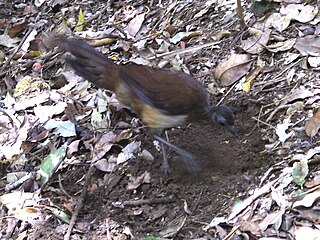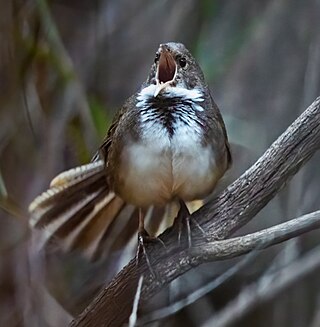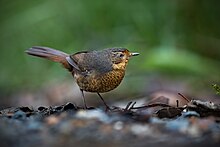
A lyrebird is either of two species of ground-dwelling Australian birds that compose the genus Menura, and the family Menuridae. They are most notable for their impressive ability to mimic natural and artificial sounds from their environment, and the striking beauty of the male bird's huge tail when it is fanned out in courtship display. Lyrebirds have unique plumes of neutral-coloured tailfeathers and are among Australia's best-known native birds.

Pardalotes or peep-wrens are a family, Pardalotidae, of very small, brightly coloured birds native to Australia, with short tails, strong legs, and stubby blunt beaks. This family is composed of four species in one genus, Pardalotus, and several subspecies. The name derives from a Greek word meaning "spotted". The family once contained several other species now split into the family Acanthizidae.

The gang-gang cockatoo is a parrot found in the cooler and wetter forests and woodlands of Australia, particularly alpine bushland. It is the only species placed in the genus Callocephalon. Mostly mild grey in colour with some lighter scalloping, the male has a red head and crest, while the female has a small fluffy grey crest. It ranges throughout south-eastern Australia. The gang-gang cockatoo is the faunal emblem of the Australian Capital Territory. It is easily identified by its distinctive call, which is described as resembling a creaky gate, or the sound of a cork being pulled from a wine bottle.

The yellow-rumped thornbill is a species of passerine bird from the genus Acanthiza. The genus was once placed in the family Pardalotidae but that family was split and it is now in the family Acanthizidae. There are four subspecies of yellow-rumped thornbill. It is a small, brownish bird with a distinctive yellow rump and thin dark bill. It inhabits savannah, scrub and forests across most of Australia and eats insects. The species engages in cooperative breeding.

The scarlet robin is a common red-breasted Australasian robin in the passerine bird genus Petroica. The species is found on continental Australia and its offshore islands, including Tasmania. The species was originally split in 1999 by Schodde and Mason, and as the original collection by Gmelin was from Norfolk Island, this retained the name of multicolor, and is now known as the Norfolk robin.

The superb lyrebird is an Australian passerine songbird, one of two species from the family Menuridae, with the other being the much rarer Albert's lyrebird. It is one of the world's largest songbirds, and is renowned for its elaborate tail and courtship displays, and its excellent mimicry. The species is endemic to Australia and is found in forest in the southeast of the country. According to David Attenborough, the superb lyrebird displays one of the most sophisticated voice skills within the animal kingdom—"the most elaborate, the most complex, and the most beautiful".

Albert's lyrebird is a timid, pheasant-sized songbird which is endemic to subtropical rainforests of Australia, in a small area on the state border between New South Wales and Queensland. The rarer of the two species of lyrebirds, Albert's lyrebird is named after Prince Albert, the prince consort of Queen Victoria, queen of the United Kingdom. It lacks the elegant lyre-shaped tail feathers of the superb lyrebird and is found in a much more restricted range.

The yellow-tufted honeyeater is a passerine bird found in the south-east ranges of Australia. A predominantly black and yellow honeyeater, it is split into four subspecies.

The genus Ptiloris consists of four allopatric species of birds in the family Paradisaeidae. These birds of paradise are commonly known as riflebirds, so named for the likeness of their black velvety plumage to the uniform of the Rifle Brigade. Alternatively, the bird's cry is similar to a rifle being fired and hitting its target but a call like this is not commonly reported. They are distributed in the rainforests of New Guinea and Eastern Australia.

The olive whistler or olivaceous whistler, is a species of bird in the family Pachycephalidae, the whistlers, that is native to southeastern Australia.

The scrubtit is a species of bird in the thornbill family Acanthizidae. It is endemic to Tasmania and King Island in Australia. Its natural habitat is the temperate rainforest, Nothofagus beech forest and eucalypt woodland. It is a small species that resembles the Sericornis scrubwrens.

The noisy scrubbird is a species of bird in the family Atrichornithidae. It is endemic to the coastal heaths of south-western Australia.

The speckled warbler is a species of bird in the family Acanthizidae. It is endemic to eastern Australia. Its natural habitat is temperate forests.

The crescent honeyeater is a passerine bird of the honeyeater family Meliphagidae native to southeastern Australia. A member of the genus Phylidonyris, it is most closely related to the common New Holland honeyeater and the white-cheeked honeyeater. Two subspecies are recognized, with P. p. halmaturinus restricted in range to Kangaroo Island and the Mount Lofty Ranges in South Australia.

The western gerygone is a small, brownish-grey species of passerine bird, which is found in inland and south-west Australia. It is an arboreal, insectivore of open forest, woodland and dry shrubland. It is not currently threatened with extinction.

The yellow-throated honeyeater is a species of passerine bird in the honeyeater family Meliphagidae. It is similar in behaviour and appearance to the white-eared honeyeater and is endemic to Australia's island state of Tasmania. It was formerly considered a pest of orchards.

The jacky winter is a small grey-brown robin found commonly throughout Australia and also in Papua New Guinea. The jacky winter acquired its name due to rapid and strong vocalisations, which sound like jacky-jacky winter-winter. Their call is also often referred to as sounding like peter-peter-peter. Its habitats include open woodlands and farmlands.

The fernwren is a species of bird in the family Acanthizidae. It is monotypic within the genus Oreoscopus.

The large-billed scrubwren is a passerine bird in the family Acanthizidae, endemic to eastern Australia. It is found in denser undergrowth in temperate forest, subtropical or tropical moist lowland forest, and subtropical or tropical moist montane forest.

The pale-mandibled aracari or pale-billed araçari is a near-passerine bird in the toucan family Ramphastidae. It is found in Ecuador and Peru.






















